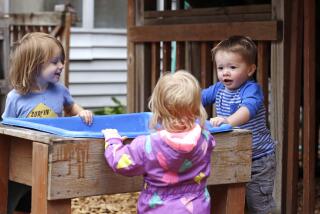In child care, being active may take back seat to safety, academics
- Share via
Child care centers might not be providing kids enough opportunities to be physically active, finds a study that explored some of the obstacles.
The study, released this week in the journal Pediatrics, reports that about three-fourths of children in the U.S. age 3 to 5 are in child care, and 56% of them are in centers: nursery schools, preschools and day care centers. Previous studies suggest they may be sedentary the majority of the time.
For this study researchers analyzed information gathered from nine focus groups that included 49 child care teachers and providers in Cincinnati. Those were followed by 13 one-on-one interviews. Topics centered on what the providers thought might be keeping the children from getting exercise.
Three main hurdles were identified: worries about injuries, budget concerns and an emphasis on academics over activity. While the day care providers recognized that exercise was important, they said that they and parents were concerned about children being hurt during active play.
They also mentioned that state licensing codes and guidelines were so severe that they could be hampering, rather than encouraging, exercise. Play equipment that did meet standards was sometimes boring to the children, causing some to use it in unsafe ways.
Money was an issue as well. Most child care centers had tight budgets, making purchases of $10,000 pieces of equipment impossible. Since parents were concerned that their children focus more on academics (such as learning shapes and colors), being physically active often took a back seat.
Still, many study participants said they understood the importance of active play and mentioned that releasing energy and having some “creative stimulation of outdoor activities” helped to put them in a better frame of mind for learning.
The authors said that with childhood obesity a serious health concern, child advocates should think about the possible unexpected consequences of regulations that are supposed to protect children, or of education policies that may cut into valuable activity time.






